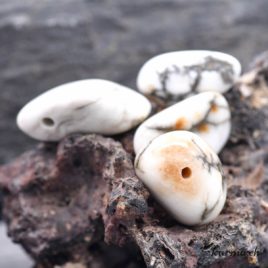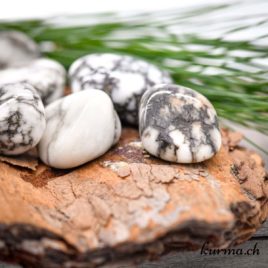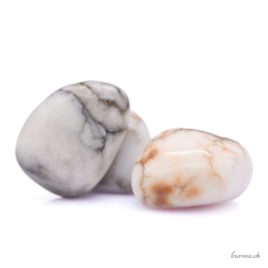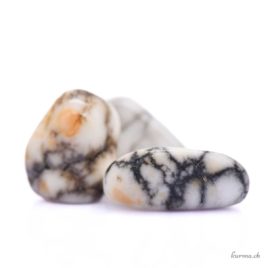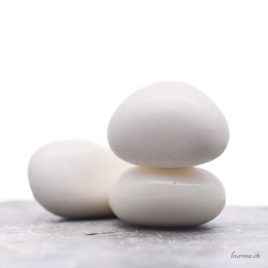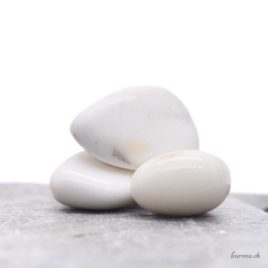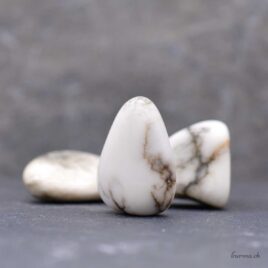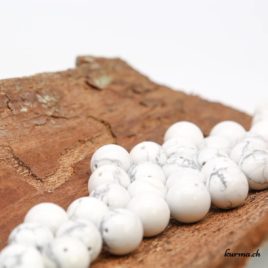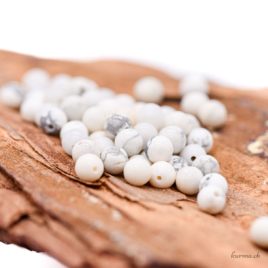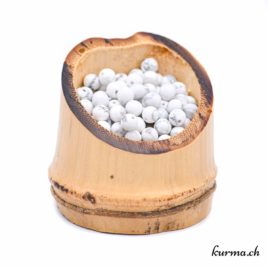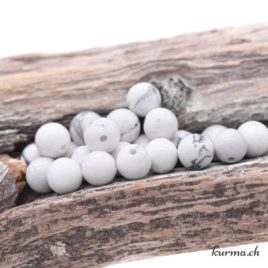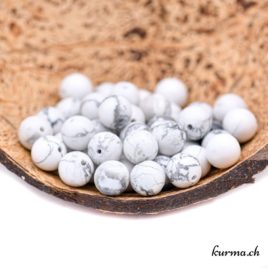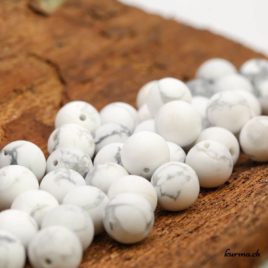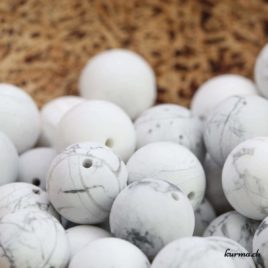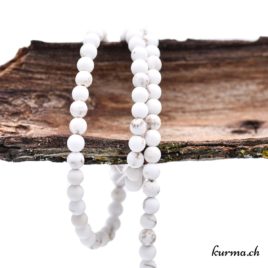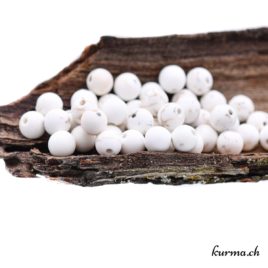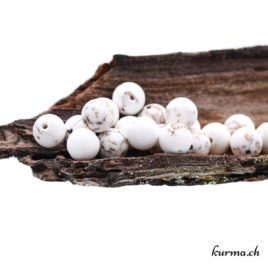White howlite
Not to be confused with Magnesite! Contrary to what is written in many books, white Howlite and carbonated Magnesite
are two different stones with different compositions and virtues.
The virtues and properties of Howlite in lithotherapy
What is the significance of Howlite?
Genuine Howlite (not to be confused with Magnesite, which is not the same stone) is a stone of balance and righteousness, encouraging us to be creators of our lives by implementing just and conscious actions.
What are the benefits of Howlite?
Howlite is an ally that helps you move forward on your path with greater awareness of your every action and word. With it, you learn to take responsibility for your life, realizing that it's you who creates your reality, with your dark and light sides.
With its emphasis on awareness and moment-by-moment consciousness, Howlite helps you improve your communication and listening skills, your memory, your learning abilities and encourages you to achieve your goals by becoming more aware of your inner and outer resources.
It can be a perfect stone for people who tend to behave selfishly, vulgarly or inappropriately without realizing it, or for people who scatter easily and never get to the end of their projects.
A fair and creative vision
For its beauty and significance, Howlite is combined with Apatite beads to create jewelry. The smooth and veined white Howlite contrasts wonderfully with the saturated colors of Apatite. In this way, listening and expression are creatively added to a fair vision of humankind and its actions.
What are the physical properties of Howlite?
Howlite can help relieve nausea and soothe the consequences of external poisoning (poison in contact with the skin). It can also be beneficial to the teeth and bone system.
Howlite can improve balance and can help people who tend to trip often, lose their balance or drop things frequently.
How to use Howlite
Howlite is best worn against the skin or as close as possible and directly on the stomach in case of nausea.
You'll find other white stones marbled with color at this link to all our white gemstones.
How do I purify Howlite?
Reload this stone
Moon, running water, waveform, fumigation, singing bowl, wind/breath, prayers...Chakras
7ᵉ chakra - CoronalElement
AirHowlite in mineralogy
Howlite is a calcium borosilicate of the mesosilicate class, containing iron oxides that create brown-red veins and manganese oxides that create black-gray veins. Secondary in formation, they are created by boron-containing liquids within Gyspe sediments. Boric acid and silicic acid mix with the calcium present in gypsum and form howlite.
It crystallizes in tiny crystals that aggregate into nodules a few centimetres in size, making it virtually impossible or very expensive to cut into doughnut, heart or other shapes, unlike Magnesite.
Its color is white or creamy white with black or brown veins and sometimes yellowish or grayish areas. Blue howlite, also known as turquenite, does not occur naturally, but is a colored stone, often from magnesite.
Howlite is a relatively rare stone and its only major deposit is in California's Mojave Desert.
What are the differences between Howlite and Magnesite?
The majority of "Howlites" sold on the market are actually Magnesites. This is also true of the "Howlites" described in numerous lithotherapy books and blogs. Why is this? Firstly, because of misunderstanding and confusion. Then, because Magnesite sold under the name Howlite sells better and costs much less, which is a godsend for unscrupulous wholesalers and sellers.
And unfortunately, even we don't sell any Magnesite beads without the word " howlite " in quotation marks.
These two stones, although similar in appearance, do not at all have the same composition or the same lithotherapy virtues.
Howlite (as mentioned above) is a calcium borosilicate and Magnesite is a magnesium carbonate. Not the same thing at all!
Magnesite is a widespread, inexpensive mineral, which can easily be given all sorts of shapes, which is not the case with Howlite.
But how can you tell them apart? The only sure way is to grind your stones into powder and test with 10% hydrochloric acid. Magnesite develops gas bubbles, while Howlite takes the form of a jelly-like mass. Howlite is not found in Zimbabwe.
History and uses of Howlite
Described for the 1st time by mineralogist Henry How, from whom it takes its name, Howlite unfortunately owes its notoriety to the confusion that reigns between it and Magnesite. Magnesite has been sold under the name Howlite for many years.
Howlite is mainly used in jewelry and as a therapeutic stone.
Mineralogy
- Hardness :
- 3.0-3.5
- Moths scale:
- 3
- Strunz classification :
- Borate
- Crystalline system :
- Monoclinic
- Chemical element :
- Ca, B, Si, O, H
- Line color :
- White
- Density :
- 2.45-2.54
- Cleavage :
- No
- Fracture:
- Uneven, earthy
- Refringence :
- nα = 1.583 - 1.586, nβ = 1.596 - 1.598, nγ = 1.600
- Birefringence :
- Biaxial (-); δ = 0.017
- Colors :
- White, colorless
Other white stones
*Please note! Some minerals may be toxic and must not be licked or ingested (as such or in the form of powder, elixir or stone water) or be in prolonged contact with the skin or mucous membranes.
*The information on the stones described here are general indications based on our research and experience, and are not exhaustive.
Reproduction in whole or in part of this content is prohibited. More info

